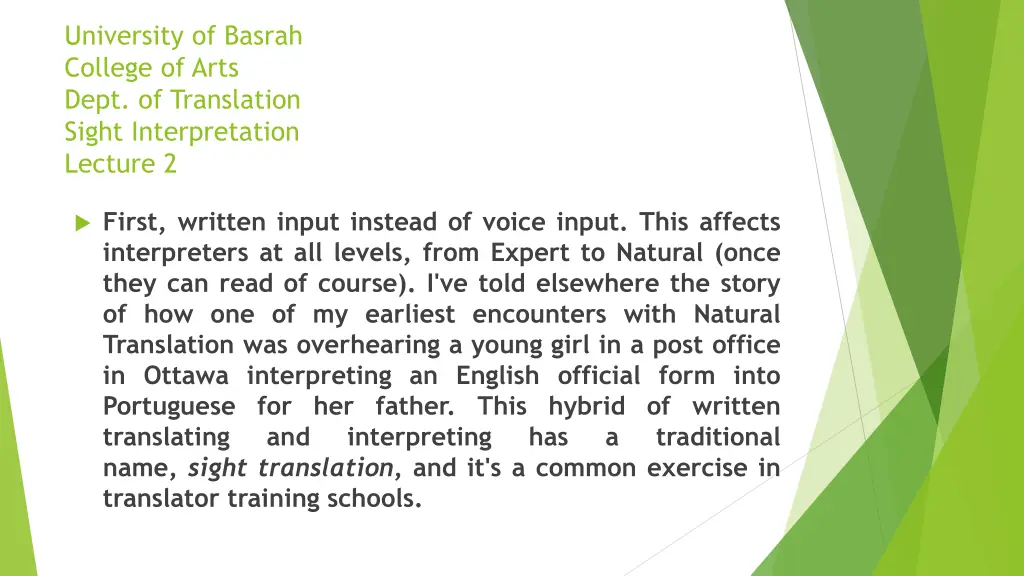
Understanding Sight Translation in Interpreter Training Schools
Learn about the hybrid practice of sight translation in interpreter training schools, its importance in various interpreting scenarios, and the challenges it presents to interpreters at different levels. Discover how sight interpreters navigate between written text and verbal translation, ensuring smooth communication in multilingual settings.
Download Presentation

Please find below an Image/Link to download the presentation.
The content on the website is provided AS IS for your information and personal use only. It may not be sold, licensed, or shared on other websites without obtaining consent from the author. If you encounter any issues during the download, it is possible that the publisher has removed the file from their server.
You are allowed to download the files provided on this website for personal or commercial use, subject to the condition that they are used lawfully. All files are the property of their respective owners.
The content on the website is provided AS IS for your information and personal use only. It may not be sold, licensed, or shared on other websites without obtaining consent from the author.
E N D
Presentation Transcript
University of Basrah College of Arts Dept. of Translation Sight Interpretation Lecture 2 First, written input instead of voice input. This affects interpreters at all levels, from Expert to Natural (once they can read of course). I've told elsewhere the story of how one of my earliest encounters with Natural Translation was overhearing a young girl in a post office in Ottawa interpreting an English official form into Portuguese for her father. This hybrid of written translating and interpreting name, sight translation, and it's a common exercise in translator training schools. has a traditional
It's good practice these days for dictating translations, whether to a secretary or to a computer. At a more advanced level, Expert Court Interpreters, for example, are often handed documents in court and required to give a verbal translation of them on the spot. What's less apparent is that there's a good deal of sight translation in conference happens because many speakers are in fact reading aloud from a prepared text and make a copy of it available sometimes in advance. interpreting. It to the interpreters,
the General Assembly in their own language whatever it may be. But there's also a proviso: if the head of state chooses a non-official language, then his or her delegation must provide the UN interpreters with a prepared translation into one of the official languages. (Muammar Gaddafi once threw the UN Arabic interpreters into a loop by speaking in Arabic, but in his own Libyan dialect instead of the Standard Arabic normally spoken at conferences and without providing a translation
Why listen while reading? For one thing, to keep in step with the speaker and not have the interpreter race ahead, which would be disconcerting for the audience. In any case, sight interpreting is difficult, because it requires attention to two input channels as well channel. It's not for Natural Interpreters, and as Andrew interpreters are unprofessional." as a third output says, "most church
." Even in Expert Conference Interpreting, if there are two interpreters in the booth then the one not currently interpreting should keep an ear on the one who is and another ear on the speaker in order to give the working colleague a nudge in the event that the latter gets out of step. At the UN, the written translation provided for speakers in a non-official language is read out by a regular UN interpreter.
But the UN interpreter can't understand and follow the speaker, so who's to keep speaker and interpreter in step? That task is performed by someone who does understand the speaker's language, usually a member of his or her delegation, and does so by pointing to the segment of the translation that corresponds to what the speaker is saying at the moment. For which reason, the person is known jokingly as the finger man.
Homework Lecture 2 Fill the blanks 1. This hybrid of written translating and interpreting has a traditional name, ---------- translation, and it's a common exercise in translator ------- schools. 2. Why listen while reading in sight interpreting? 3.Write an essay on the importance of reading in sight interpreting 4. What does the interpreter do in Conference Interpreting ? 5.
